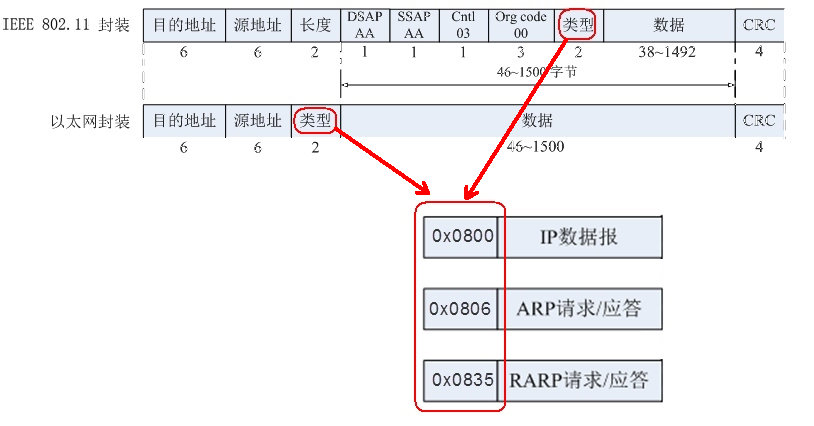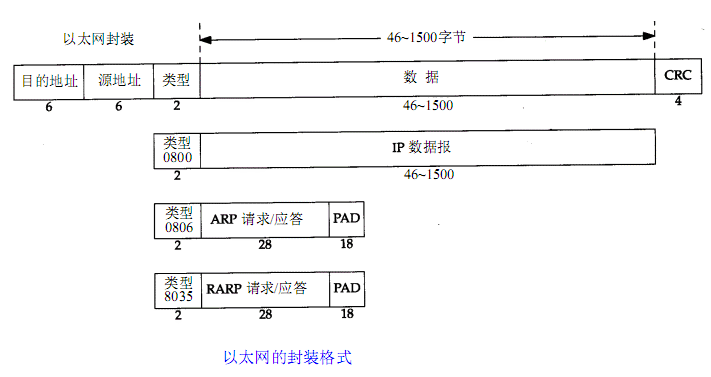Linux网络编程——原始套接字实例:MAC 头部报文分析
一、前导通过《Linux网络编程——原始套接字编程》得知,我们可以通过原始套接字以及 recvfrom( ) 可以获取链路层的数据包,那我们接收的链路层数据包到底长什么样的呢?二、链路层封包格式三、MAC 头部(有线局域网)注意:CRC、PAD 在组包时可以忽略四、链路层数据包的其中一种情况:[
·
一、前导
通过《Linux网络编程——原始套接字编程》得知,我们可以通过原始套接字以及 recvfrom( ) 可以获取链路层的数据包,那我们接收的链路层数据包到底长什么样的呢?
二、链路层封包格式
三、MAC 头部(有线局域网)
注意:CRC、PAD 在组包时可以忽略
四、链路层数据包的其中一种情况:
- unsigned char msg[1024] = {
- //--------------组MAC--------14------
- 0xb8, 0x88, 0xe3, 0xe1, 0x10, 0xe6, // dst_mac: b8:88:e3:e1:10:e6
- 0xc8, 0x9c, 0xdc, 0xb7, 0x0f, 0x19, // src_mac: c8:9c:dc:b7:0f:19
- 0x08, 0x00, // 类型:0x0800 IP协议
- // …… ……
- // …… ……
- };
五、接收的链路层数据包,并对其进行简单分析:
- #include <stdio.h>
- #include <string.h>
- #include <stdlib.h>
- #include <sys/socket.h>
- #include <netinet/in.h>
- #include <arpa/inet.h>
- #include <netinet/ether.h>
- int main(int argc,charchar *argv[])
- {
- int i = 0;
- unsigned char buf[1024] = "";
- int sock_raw_fd = socket(PF_PACKET, SOCK_RAW, htons(ETH_P_ALL));
- while(1)
- {
- unsigned char src_mac[18] = "";
- unsigned char dst_mac[18] = "";
- //获取链路层的数据帧
- recvfrom(sock_raw_fd, buf, sizeof(buf),0,NULL,NULL);
- //从buf里提取目的mac、源mac
- sprintf(dst_mac,"%02x:%02x:%02x:%02x:%02x:%02x", buf[0], buf[1], buf[2], buf[3], buf[4], buf[5]);
- sprintf(src_mac,"%02x:%02x:%02x:%02x:%02x:%02x", buf[6], buf[7], buf[8], buf[9], buf[10], buf[11]);
- //判断是否为IP数据包
- if(buf[12]==0x08 && buf[13]==0x00)
- {
- printf("______________IP数据报_______________\n");
- printf("MAC:%s >> %s\n",src_mac,dst_mac);
- }//判断是否为ARP数据包
- else if(buf[12]==0x08 && buf[13]==0x06)
- {
- printf("______________ARP数据报_______________\n");
- printf("MAC:%s >> %s\n",src_mac,dst_mac);
- }//判断是否为RARP数据包
- else if(buf[12]==0x80 && buf[13]==0x35)
- {
- printf("______________RARP数据报_______________\n");
- printf("MAC:%s>>%s\n",src_mac,dst_mac);
- }
- }
- return 0;
- }
记得以管理者权限运行程序:
每个报文头部都有一个相应的结构体,通过这些结构体对报文进行相应的组包或拆包会方便很多。
ubuntu 12.04 中描述网络协议结构的文件如下:
六、以太网头部(所需要头文件:#include <net/ethernet.h>):
上面的例子,改为用结构体实现,如下:
- #include <stdio.h>
- #include <string.h>
- #include <stdlib.h>
- #include <sys/socket.h>
- #include <netinet/in.h>
- #include <arpa/inet.h>
- #include <netinet/ether.h>
- #include <net/ethernet.h> // 以太网头部 头文件
- #include <netinet/ip.h> // ip头部 头文件
- // #include <net/if_arp.h> // arp头部 头文件
- int main(int argc,charchar *argv[])
- {
- int i = 0;
- unsigned char buf[1024] = "";
- int sock_raw_fd = socket(PF_PACKET, SOCK_RAW, htons(ETH_P_ALL));
- while(1)
- {
- unsigned char src_mac[18] = "";
- unsigned char dst_mac[18] = "";
- //获取链路层的数据帧
- recvfrom(sock_raw_fd, buf, sizeof(buf),0,NULL,NULL);
- //从数据中提取mac首部信息(14个字节)
- struct ether_header *ethdr = NULL;
- ethdr = (struct ether_header *)buf;
- //从buf里提取目的mac、源mac
- sprintf(dst_mac,"%02x:%02x:%02x:%02x:%02x:%02x", ethdr->ether_dhost[0], ethdr->ether_dhost[1],ethdr->ether_dhost[2],ethdr->ether_dhost[3],ethdr->ether_dhost[4],ethdr->ether_dhost[5]);
- sprintf(src_mac,"%02x:%02x:%02x:%02x:%02x:%02x", ethdr->ether_shost[0], ethdr->ether_shost[1],ethdr->ether_shost[2],ethdr->ether_shost[3],ethdr->ether_shost[4],ethdr->ether_shost[5]);
- //判断是否为IP数据包
- if( 0x0800 == ntohs(ethdr->ether_type) )
- {
- printf("______________IP数据报_______________\n");
- printf("MAC:%s >> %s\n",src_mac,dst_mac);
- }//0x0806为ARP数据包, 0x8035为RARP数据包
- else if( 0x0806 == ntohs(ethdr->ether_type) || 0x8035 == ntohs(ethdr->ether_type) )
- {
- printf("______________ARP数据报_______________\n");
- printf("MAC:%s >> %s\n",src_mac,dst_mac);
- }
- }
- return 0;
- }
更多推荐
 已为社区贡献5条内容
已为社区贡献5条内容












所有评论(0)